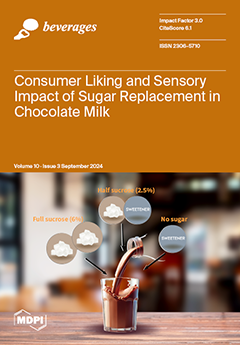An undesirable sensory attribute (“floral taint”) has recently been detected in red wines from some winegrowing jurisdictions in North America (e.g., Ontario, British Columbia, Washington), caused by the introduction of frost-killed leaves and petioles [materials-other-than-grapes (MOG)] during mechanical harvest and winemaking. It was hypothesized that terpenes, norisoprenoids, and higher alcohols would be the main responsible compounds. The objectives were to investigate the causative volatile compounds for floral taint and explore threshold concentrations for this problem. Commercial wines displaying varying intensities of floral taint were subjected to GC-MS and sensory analysis. Several odor-active compounds were higher in floral-tainted wines, including terpenes (geraniol, citronellol,
cis- and
trans-rose oxide), norisoprenoids (β-damascenone, β-ionone), five ethyl esters, and three alcohols. Thereafter, fermentations of Cabernet Franc (CF) and Cabernet Sauvignon (CS) (2016, 2017) were conducted. MOG treatments were (
w/
w): 0, 0.5%, 1%, 2%, and 5% petioles, and 0, 0.25%, 0.5%, 1%, and 2% leaf blades. Terpenes (linalool, geraniol, nerol, nerolidol, citronellol, citral,
cis- and
trans-rose oxides, eugenol, myrcene), norisoprenoids (α- and β-ionone), and others (e.g., hexanol, octanol, methyl and ethyl salicylate) increased linearly/quadratically with increasing MOG levels in both cultivars. Principal components analysis separated MOG treatments from the controls, with 5% petioles and 2% leaves as extremes. Increasing MOG levels in CF wines increased floral aroma intensity, primarily associated with terpenes, higher alcohols, and salicylates. Increased leaf levels in CF were associated with higher vegetal and earthy attributes. Increased petioles in CS were not correlated with floral aromas, but increased leaves increased floral, vegetal, and herbaceous attributes. Overall, petioles contributed more to floral taint than leaves through increased terpenes and salicylates (floral notes), while leaves predominantly contributed norisoprenoids and C
6 alcohols (green notes).
Full article





